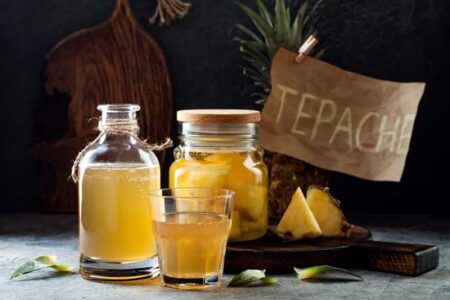My grandmother’s recipe box has several wine recipes, including dandelion, rhubarb, gooseberry, and grape. As soon as I laid eyes on the rhubarb wine recipe, I knew we had to try it as well. Our backyard rhubarb patch supplies us with more than what we need for pies and jam. No better way to use the excess than in wine!
Because we have a friend with a large blueberry patch, we also have an excellent supply of blueberries every year. Straight rhubarb wine seemed like it might be a little rough, so we modified Grandma’s recipe by substituting blueberries for half the fruit.
Making wine takes at least 10 months. But with lots of care, some skill and a little luck, it can really be worth the wait.
If you’ve never made a fruit wine, you’ll want to visit a beer/wine making supply store for equipment and help.
“Bluebarb” (Rhubarb/Blueberry) Wine
Ingredients:
- 2-1/2 pounds rhubarb
- 2-1/2 pounds blueberries
- 5 pounds white sugar
- 1-1/2 gallons water
- 2 Campden tablets
- 1 teaspoon acid blend
- 1/2 teaspoon grape tannin
- 1 package Red Star Cote des Blanc Yeast (dry wine yeast) plus another 1/2 cup warm water
Make sure to start with frozen, chopped rhubarb. When rhubarb is frozen and thawed it releases its liquid a lot easier, which is your goal, so make sure your rhubarb has been in the freezer for at least a few days before you start. We also started with semi-frozen blueberries. The blueberries need to be chopped just a bit in your food processor, otherwise they are very hard to burst. We found it was best to chop them slightly frozen so they don’t completely turn to mush.
Line a plastic fermenting bucket with a straining bag. Put your thawed, chopped rhubarb and roughly chopped blueberries into the bag. Add a 5 pound bag of sugar. Mix well. Cover and let stand for 24 hours.
Use straining bag to drain as much liquid out as possible. Pour about a half a gallon of water into bag at a time to rinse the pulp repeatedly until your remaining pulp is as well-rinsed as possible.
After rinsing and discarding pulp, add Campden tablets, acid blend and grape tannin. Cover bucket with lid and place air lock in the hole on the cover. (Air lock relies on a small amount of water to operate.) The Campden tablets will kill all of the wild yeast present on your fruit and any other accidental contamination. You need to wait 48 hours so that the tablets dissipate and don’t kill the yeast you are about to add.
Start your yeast (any good wine or Champagne yeast will work) 48 hours after straining fruit by stirring it into 1/2 cup warm water. Open your fermenter and add the yeast. Cover and replace fermentation lock.
Allow to ferment three months or until the float in the air lock has settled.
Open fermenter and transfer wine to a glass carboy using a siphon tube and 1/4-inch tubing, being very careful to limit the amount of oxygenation. Replace air lock and let rest in carboy for another 2 to 3 month at which time the wine can be bottled.
Siphon off from carboy, bottle and cork.
Age in the bottle at least six months. Open a bottle and toast the success of your efforts.










